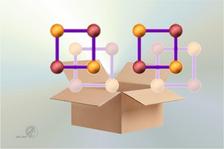Checkerboard charge order on the Fe sites in Sr3Fe2O7. The two stacking patterns of charge order in adjacent FeO2 layers occur nearly randomly (Copyright: MPI for Solid State Research, Stuttgart, Germany).
Electronic phase transitions in solids manifest themselves as anomalies in macroscopic properties, such the magnetisation and electrical resistance. Prominent examples are the sharp increase in the magnetisation at a ferromagnetic phase transition or the drop in resistance at a superconducting transition. In the history of solid-state physics it has often taken considerable effort and ingenuity to resolve the microscopic nature of the phases separated by such transitions. For instance, antiferromagnetic phase transitions had been recognised through anomalies in the magnetisation long before the development of neutron diffraction which finally allowed direct detection of antiferromagnetic order some seventy years ago. Even today, some materials exhibit pronounced anomalies in thermodynamic and transport experiments whose origin has defied experimental identification. Such "hidden order" materials have motivated intense theoretical research on exotic forms of electronic order that cannot be detected by standard experimental probes.
An international team of researchers from the Max-Planck-Institute for Solid State Research in Stuttgart, the Technische Universität Dresden (Germany) and other institutions has used a combination of two advanced scattering methods at synchrotron and neutron sources to resolve the origin of a pronounced phase transition in the layered perovskite Sr3Fe2O7 around-room temperature. This effect was first reported more than fifty years ago. At that time, Mössbauer spectroscopy had identified two different valence states of the iron ions in the low-temperature phase but all attempts to elucidate the spatial arrangement of these states by X-ray and neutron diffraction had failed in the ensuing years.
The solution of this conundrum was made possible by Neutron Larmor Diffraction (NLD) on the TRISP spectrometer at the neutron source Heinz Maier-Leibnitz (FRM II in Garching), an advanced scattering method capable of detecting minute modifications of the lattice parameters and by Resonant Elastic X-ray Scattering (REXS) at the PETRA III beamline P09 at DESY which uses photons close to the X-ray absorption edge of iron to enhance the sensitivity to differences in the valence states of the iron atoms. Further measurements were performed at the synchrotron source ESRF (Grenoble, France).
The two iron valence states turn out to form a surprisingly simple "checkerboard" pattern in the FeO2 square layers, but the checkerboards in adjacent layers are stacked in a nearly random fashion. A sharp phase transition is observed nonetheless because the forces driving the charge-ordering transition are essentially two-dimensional. Whereas the stacking disorder perpendicular to the layers weakens corresponding diffraction features beyond the sensitivity of standard methods, REXS is sensitive enough to detect unambiguous signatures of the planar checkerboard order.
The solution of the fifty-year-old Sr3Fe2O7 conundrum holds an important lesson for research on other hidden-order materials as well: due to the impact of lattice disorder, even simple forms of electronic order can be surprisingly hard to detect.
(from MPI-News)
Reference:
Hidden Charge Order in an Iron Oxide Square-Lattice Compound, J.-H. Kim, D.C. Peets, M. Reehuis, P. Adler, A. Maljuk, T. Ritschel, M.C. Allison, J. Geck, J.R.L. Mardegan, P.J. Bereciartua Perez, S. Francoual, A.C. Walters, T. Keller, P.M. Abdala, P. Pattison, P. Dosanjh, B. Keimer, Physical Review Letters (2021), DOI: 10.1103/PhysRevLett.127.097203







